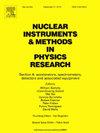辐照MALTA2 Czochralski传感器二元命中数据的电荷重建
IF 1.4
3区 物理与天体物理
Q3 INSTRUMENTS & INSTRUMENTATION
Nuclear Instruments & Methods in Physics Research Section A-accelerators Spectrometers Detectors and Associated Equipment
Pub Date : 2025-06-23
DOI:10.1016/j.nima.2025.170747
引用次数: 0
摘要
MALTA2是一种耗尽单片有源像素传感器(DMAPS),设计用于高速率跟踪,采用改进的Tower 180 nm CMOS成像技术生产。像素间距为36.4µm,传感层由高电阻率外延硅或Czochralski硅组成。一种小型收集电极的实现具有小像素电容并且提供低噪声。通常使用200 e−左右的检测阈值。它是利用芯片上的专用电荷注入电路和Fe-55源进行校准的。在这一贡献中,MALTA2传感器的特点是在精细阈值步骤下像素内部的命中检测效率。对不同衬底电压和不同内n层掺杂浓度下辐照前后样品进行了比较。数据于2023年和2024年在CERN SPS测试波束运动中使用马耳他波束望远镜,该望远镜由6个马耳他跟踪面组成,空间分辨率为4µm,时间分辨率为2ns。从二进制命中数据中重建最可能的信号幅度。以亚像素分辨率获得所收集电荷的二维图。所提出的方法提供了一种光束内替代掠掠角研究或边缘tct来确定电荷收集剖面。本文章由计算机程序翻译,如有差异,请以英文原文为准。
Charge reconstruction from binary hit data on irradiated MALTA2 Czochralski sensors
MALTA2 is a depleted monolithic active pixel sensor (DMAPS) designed for tracking at high rates and is produced in the modified Tower 180 nm CMOS imaging technology. The pixel pitch is 36.4 µm and the sensing layer consists of either high resistivity epitaxial or Czochralski silicon. The implementation of a small collection electrode features a small pixel capacitance and offers low noise. Typically a detection threshold of around 200 e− is used. It is calibrated making use of a dedicated charge injection circuit on chip and an Fe-55 source. In this contribution, MALTA2 sensors are characterized in terms of hit detection efficiency inside the pixel at fine threshold steps. A comparison is made for samples before and after irradiation at different substrate voltages and with different doping concentration of the internal n-layer. Data was taken at CERN SPS test beam campaigns in 2023 and 2024, using the MALTA beam telescope consisting of six MALTA tracking planes with 4 µm spatial and 2 ns timing resolution. A reconstruction of the most probable signal amplitude from binary hit data is performed. A two-dimensional map of the collected charge is obtained with sub-pixel resolution. The presented method provides an in-beam alternative to grazing angle studies or Edge-TCT for determining a charge collection profile.
求助全文
通过发布文献求助,成功后即可免费获取论文全文。
去求助
来源期刊
CiteScore
3.20
自引率
21.40%
发文量
787
审稿时长
1 months
期刊介绍:
Section A of Nuclear Instruments and Methods in Physics Research publishes papers on design, manufacturing and performance of scientific instruments with an emphasis on large scale facilities. This includes the development of particle accelerators, ion sources, beam transport systems and target arrangements as well as the use of secondary phenomena such as synchrotron radiation and free electron lasers. It also includes all types of instrumentation for the detection and spectrometry of radiations from high energy processes and nuclear decays, as well as instrumentation for experiments at nuclear reactors. Specialized electronics for nuclear and other types of spectrometry as well as computerization of measurements and control systems in this area also find their place in the A section.
Theoretical as well as experimental papers are accepted.

 求助内容:
求助内容: 应助结果提醒方式:
应助结果提醒方式:


